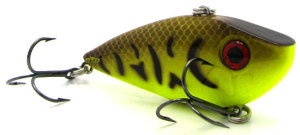Andrew Ragas fishes a 300 acre eutrophic lake in Oneida County Wisconsin for largemouth bass, on a new lake he’s never visited before. Major coldfront hit and a flurry of fish were caught on Strike King RedEye Shads and Pure Poison Chatterbaits.
Lake Profile
Size: 300 acres
Lake Type: Eutrophic
Maximum Depth: 25 feet
Avg. Depth Fished: 2 to 6 feet
Water Clarity: Light brown
Primary Fishery: Largemouth bass, northern pike, crappie, bluegill,
Areas of Focus: Shallow weed bars, island saddles, bog shorelines, flooded bushes, downed wood, emerging weedgrowth
Time of Day: Midday
Lure Used: Strike King RedEye Shad (Chartreuse Belly Craw)

Lipless crankbaits are one of the best solutions for conquering coldfronts and successful early spring bass fishing. With many lipless crankbaits featuring lifelike patterns and baitfish finishing, they are some of the most effective lures on the market to entice ferocious strikes.
They’ve been considered a “dummy lure” by bass fishing purists and elitists, requiring little skill and minimal effort to succeed in the underwater worlds below. However, lipless crankbaits are not all the same by shape, sound, or color. In fact, the components allowing them to succeed such as internal rattle chambers, lifelike patterning, and shape are actually quite technical and diverse. While the designs from every major manufacturer may look similar in shape and profile, not every brand or model of lipless crankbaits behaves the same. The best lipless crankbaits will rip, wiggle, and generate reactionary strikes.
In early spring, I’m often faced with brutal northwest winds and coldfronts. It leads to generally uncomfortable fishing conditions as illustrated in the video above, but the payoff is hungry bass, and lots of them.
This time of year, both largemouth bass and their forage species (yellow perch, bluegills, shiners, suckers) are lethargic, but slowly awakening. Bass aren’t likely to travel great distances to feed and herd their prey. To improve odds in having days like this, it’s important to make your presentation stand out by color selection and speed retrieving.
The Red Eye Shad features some of the most unique color scheme to represent baitfish and forage species, along with 3D red eyes and premium VMC vanadium cone cut treble hooks. The Red eye shad I used on this day was 1/2 oz., fished with Quantum PT’s Energy 7 foot medium action fiberglass crankbait rod paired with a Quantum REAX PT (7.3;1 gear ratio) spooled with 14 lb. Cortland Endurance monofilament. This unique rod and reel combination of mine is used exclusively for speed cranking with lipless crankbaits. I try to utilize various retrieves, but with rod tip pointed high and with several rapid pops and rips in between, a continuous speed retrieve usually generates a positive response from fish.
Because largemouth bass location may vary on a lake-by-lake basis and is influenced by weather patterns, it’s important to cover water efficiently when developing a productive lipless crankbait pattern. On this particular 300 acre eutrophic lake, the system called for controlled drifting, and zig-zagging across shallow sand flats, island saddles, and feeding shelves located along the windblown areas of the lake. The Strike King RedEye Shad gave me the ability to fish quickly and search for bites without wasting precious fishing time on a new, unfamiliar body of water. Lipless crankbaits never cease to amaze me by how much water you can cover in a day of fishing with them. They may not catch every bass you make contact with, but they are outstanding at triggering the most dominant and active fish.
If you’re up to braving the cold spring weather and expect good results, take a day to fish with a lipless crankbait. If you can learn where to throw it, how to work it and how to unleash its full potential, you’ll enjoy some of the most exciting bass action of the season.




